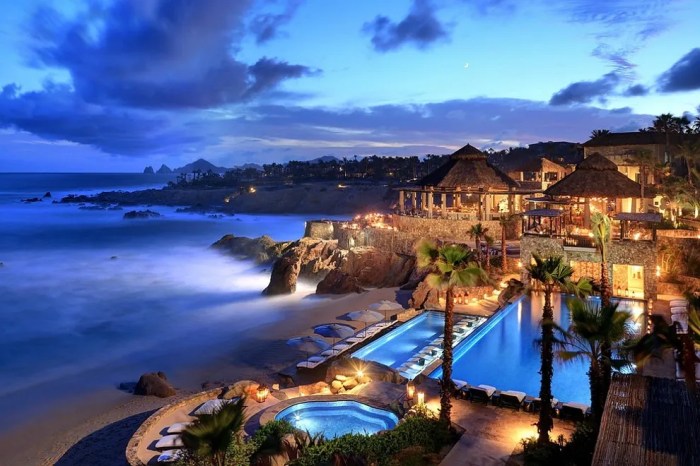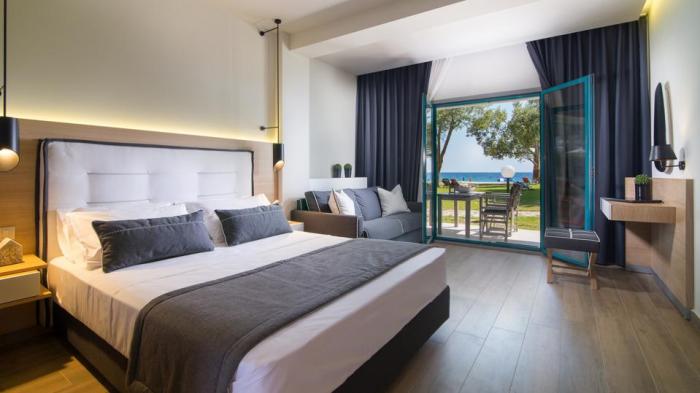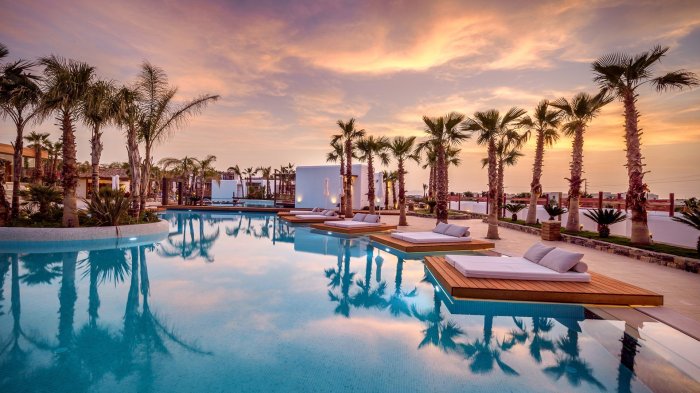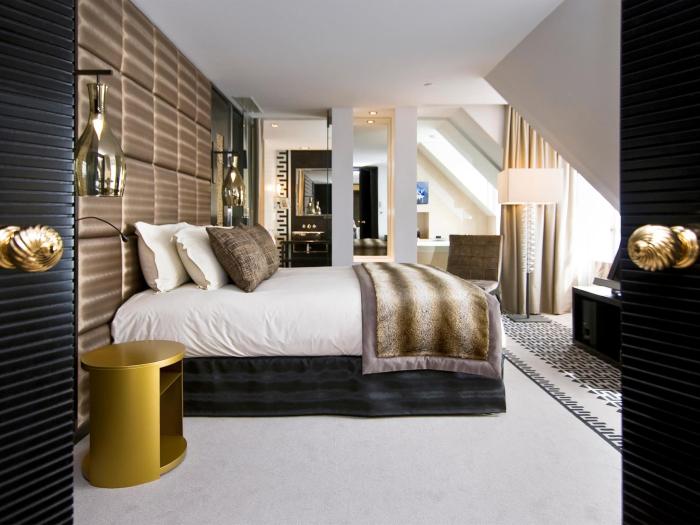Luxury Hotel and Resort Collection A Deep Dive

Luxury hotel and resort collections represent the pinnacle of hospitality, offering curated experiences that go beyond a simple stay. These aren’t just individual hotels; they’re brands, promising consistent high-quality service and unique amenities across multiple locations. We’ll explore what defines these collections, analyze their competitive landscape, and delve into the strategies that drive their success. This includes marketing, branding, guest experience, sustainability, and the role of technology in shaping the future of luxury travel.
From understanding the target audience—the discerning traveler seeking unparalleled luxury—to examining successful marketing campaigns and innovative service offerings, we’ll uncover the secrets behind these exclusive brands. We’ll also consider the crucial elements of sustainability and corporate social responsibility, increasingly important aspects of the luxury hospitality sector. Get ready to explore the world of high-end hospitality!
Defining “Luxury Hotel and Resort Collection”
A luxury hotel and resort collection represents a curated group of individual luxury properties, united under a single brand umbrella. Unlike a single luxury hotel operating independently, a collection offers a portfolio of distinct experiences, each maintaining its unique character while sharing a commitment to exceptional service and unparalleled amenities. This synergistic approach allows for broader market reach and enhanced brand recognition.
A luxury hotel and resort collection is more than just a sum of its parts. It’s a carefully constructed brand identity built upon shared values, consistent service standards, and a commitment to providing a consistently high level of luxury across diverse locations and property styles. The collection’s brand identity often reflects a specific aesthetic, a commitment to sustainability, or a particular style of luxury (e.g., understated elegance, opulent grandeur, adventurous exploration). This consistent brand messaging is crucial in establishing a strong market position and attracting the target clientele.
Key Characteristics of a Luxury Hotel and Resort Collection Brand
The defining characteristics of a successful luxury hotel and resort collection hinge on a combination of factors. These include meticulously curated properties, each offering unique experiences while adhering to high standards of quality and service. A strong brand identity that resonates with the target audience is also crucial, along with a robust loyalty program to reward repeat guests and foster brand affinity. Furthermore, a dedicated team focused on maintaining consistent quality across all properties is essential for success. Finally, a strong digital presence and strategic marketing initiatives are needed to reach and engage potential guests.
Target Audience for a Luxury Hotel and Resort Collection
The target audience for a luxury hotel and resort collection is discerning travelers who appreciate exceptional experiences and personalized service. These individuals value exclusivity, authenticity, and seamless experiences. They are often high-net-worth individuals or affluent professionals who are willing to invest in high-quality accommodations and services. They seek unique and memorable travel experiences, and the collection’s diverse portfolio of properties caters to their varied preferences and travel styles.
Ideal Guest Profile
The ideal guest of a luxury hotel and resort collection is characterized by a high level of disposable income, a preference for bespoke experiences, and a strong appreciation for personalized service. They are often well-traveled and sophisticated, seeking unique and memorable travel experiences. They value authenticity and local immersion, while also appreciating the convenience and consistency of a globally recognized luxury brand. Also, they are digitally savvy and expect seamless online booking and communication channels. Examples include successful entrepreneurs, high-level executives, and discerning families seeking luxurious vacations. This profile is further refined by demographic factors such as age, location, and travel habits, allowing for targeted marketing and personalized offerings.
Competitive Landscape Analysis of Luxury Hotel and Resort Collections
The luxury hotel and resort market is fiercely competitive, with numerous established brands vying for the attention of discerning travelers. Understanding the competitive landscape is crucial for any new entrant or existing player aiming to thrive. This analysis focuses on three leading collections to illustrate key strategies and challenges.
Comparison of Three Leading Luxury Hotel and Resort Collections
This section compares Four Seasons Hotels and Resorts, The Ritz-Carlton, and Aman Resorts, highlighting their unique selling propositions (USPs), competitive advantages, and disadvantages. Each brand caters to a slightly different segment of the luxury market, demonstrating the diversity within the sector.
| Collection | USP | Competitive Advantages | Competitive Disadvantages |
|---|---|---|---|
| Four Seasons Hotels and Resorts | Consistent high-quality service and amenities across a global portfolio; personalized service. | Strong brand recognition, extensive global reach, consistent service standards, and excellent loyalty program. | Can be perceived as somewhat less unique or “experiential” compared to boutique brands; and potentially higher price points than some competitors. |
| The Ritz-Carlton | Legendary service, opulent accommodations, and a focus on creating memorable experiences. | Exceptional service culture, strong brand heritage, commitment to personalized guest experiences, and strategic location choices. | Potentially higher price points than some competitors; maintaining consistency of service across a large portfolio can be challenging. |
| Aman Resorts | Exclusive, secluded resorts focusing on tranquility, minimalist design, and personalized service. | Unique and highly desirable properties, focus on privacy and serenity, strong appeal to high-net-worth individuals. | A limited number of properties, high price point, potentially less accessible to a broader market segment. |
Successful Marketing Strategies Employed by Luxury Hotel and Resort Collections
Effective marketing is crucial for attracting and retaining high-spending guests in the luxury sector. These collections employ diverse strategies to reach their target audience.
Four Seasons leverages a strong digital presence, including targeted advertising and social media engagement, showcasing their properties and emphasizing personalized service. The Ritz-Carlton focuses on building relationships with high-net-worth individuals through exclusive events and personalized concierge services. Aman Resorts often utilizes word-of-mouth marketing and partnerships with luxury travel agencies, capitalizing on their exclusivity and reputation.
SWOT Analysis of a Hypothetical Luxury Hotel and Resort Collection
This SWOT analysis Identifies the potential strengths, weaknesses, opportunities, and threats for a new luxury hotel and resort collection entering the market. This analysis helps to identify strategic priorities.
| Strengths | Weaknesses |
|---|---|
| Unique brand concept or theme (e.g., sustainable luxury, wellness retreats) | Lack of brand recognition |
| Strong management team with experience in the luxury hospitality sector | Limited financial resources |
| Prime locations with stunning views or unique amenities | Inexperienced staff |
| Opportunities | Threats |
| Growing demand for luxury travel experiences | Increased competition from existing luxury brands |
| Partnerships with luxury brands or travel agencies | Economic downturns impacting luxury travel spending |
| Expansion into new markets with high growth potential | Negative reviews or incidents impacting brand reputation |
Marketing and Branding Strategies for Luxury Hotel and Resort Collections

Source: 10bestmedia.com
Crafting a successful marketing and branding strategy for a luxury hotel and resort collection requires a deep understanding of the target audience, a distinct brand identity, and a robust digital presence. This involves carefully selecting marketing channels, building a strong brand narrative, and consistently engaging with potential and existing guests.
Marketing Plan for a New Luxury Hotel and Resort Collection
A comprehensive marketing plan for a new luxury hotel and resort collection starts with defining the target audience. This involves segmenting the market based on demographics (age, income, occupation), psychographics (lifestyle, values, interests), and travel behavior (frequency, purpose, budget). For example, one segment might be affluent, experienced travelers seeking unique cultural experiences, while another might be families with high disposable income looking for luxurious family vacations. Once the target segments are identified, marketing channels can be selected to reach them effectively. High-net-worth individuals might respond well to print advertising in luxury travel magazines or targeted digital advertising on upscale websites. Families might be more receptive to social media marketing and partnerships with family-focused influencers. The plan should also Artikel key marketing messages, budget allocation, and performance metrics to track success.
Brand Identity Design for a Fictional Luxury Hotel and Resort Collection
Let’s imagine a fictional luxury hotel and resort collection called “Serene Escapes.” Its brand identity would center around tranquility and exclusivity. The logo could feature a stylized silhouette of a tranquil landscape – perhaps a mountain range at sunset or a serene beach scene – in a sophisticated, minimalist design. The color palette would incorporate calming earth tones like deep greens, sandy beige, and soft blues, accented with a luxurious gold or deep burgundy. The typography would be elegant and refined, using a serif font for headings and a clean sans-serif font for body text. This visual identity would be consistently applied across all marketing materials, websites, and physical properties to create a cohesive and memorable brand experience.
Social Media Strategy for a Luxury Hotel and Resort Collection
A successful social media strategy for a luxury hotel and resort collection prioritizes high-quality visual content, showcasing the unique experiences and amenities offered. Platforms like Instagram and Pinterest are ideal for visually driven content, while LinkedIn can be used to target corporate clients and event planners. The strategy should focus on building a community by engaging with followers, responding to comments and messages promptly, and running contests or giveaways to increase engagement. User-generated content, such as guest photos and videos, can be leveraged to build authenticity and social proof. Paid social media advertising can be used to target specific demographics and interests, reaching a wider audience. Influencer marketing, partnering with travel bloggers and luxury lifestyle influencers, can also be highly effective in reaching the target audience.
Examples of Successful Branding Campaigns for Luxury Hotel and Resort Collections
The success of a luxury hotel brand often hinges on effectively communicating its unique selling proposition and creating an aspirational image. Below is a comparison of branding approaches from several well-known luxury hotel and resort collections.
| Hotel Collection | Branding Approach | Key Marketing Channels | Target Audience |
|---|---|---|---|
| Four Seasons Hotels and Resorts | Emphasizes impeccable service and personalized experiences. Projects an image of understated elegance and sophistication. | Print advertising in luxury travel publications, digital marketing, public relations, and social media. | Affluent travelers seeking exceptional service and personalized experiences. |
| The Ritz-Carlton | Focuses on creating a sense of place and providing exceptional service. Projects an image of timeless elegance and luxury. | Similar to Four Seasons, with a strong emphasis on personalized service and curated experiences. | Discerning travelers who value tradition, impeccable service, and luxurious amenities. |
| Aman Resorts | Highlights exclusivity, tranquility, and spiritual rejuvenation. Projects an image of understated luxury and serenity. | Targeted digital marketing, partnerships with luxury travel agents, and public relations. | Affluent travelers seeking secluded, luxurious retreats with a focus on wellness and tranquility. |
| Belmond Hotels & Trains | Focuses on unique destinations and unforgettable experiences. Projects an image of adventure and exploration. | Digital marketing, partnerships with luxury travel agents, public relations, and social media. | Experienced travelers seeking unique and authentic travel experiences. |
Guest Experience and Service Excellence

Source: forbes.com
Creating an unforgettable luxury experience requires meticulous attention to every detail, from the initial booking to the final farewell. Our goal is to exceed expectations at every touchpoint, fostering loyalty and creating lasting memories for our guests. This involves a holistic approach encompassing anticipatory service, personalized attention, and a seamless, intuitive journey.
The Ideal Guest Experience
The ideal guest experience begins long before arrival. The booking process should be effortless and personalized, with dedicated concierge services available to assist with any requests. Upon arrival, guests are greeted warmly and efficiently, their luggage handled discreetly, and a smooth check-in process ensures a relaxing start to their stay. Throughout their stay, anticipatory service anticipates their needs, personalized touches reflect their preferences and seamless transitions between services ensure a fluid and effortless experience. Departure should be equally seamless, with assistance in arranging transportation and ensuring a prompt and courteous farewell. This holistic approach, focusing on both efficiency and personalized attention, sets the stage for an exceptional stay.
Key Elements of Exceptional Service
Exceptional service in a luxury hotel and resort collection is characterized by several key elements. Proactive service anticipates guest needs before they are even voiced. Personalized attention tailors the experience to individual preferences, creating a sense of exclusivity and care. Empowered employees are given the authority to resolve guest issues quickly and efficiently, fostering a sense of trust and confidence. Attentive communication keeps guests informed and engaged throughout their stay. Finally, consistent delivery ensures that every interaction meets the high standards of the collection. These elements, working in concert, create an experience that transcends mere hospitality and becomes a truly memorable event.
Staff Training and Development
Comprehensive training and development programs are crucial for delivering outstanding service. These programs should encompass various aspects, including product knowledge, service standards, conflict resolution, and communication skills. Role-playing exercises simulate real-life scenarios, allowing staff to practice their skills in a safe environment. Mentorship programs pair experienced staff with newer employees, fostering knowledge transfer and professional growth. Ongoing training ensures that staff remain up-to-date on best practices and new technologies. Continuous feedback mechanisms, including guest surveys and performance reviews, provide valuable insights for improvement. This commitment to ongoing training empowers staff to consistently deliver exceptional service and contribute to the overall success of the collection.
Innovative Service Offerings
The luxury hospitality landscape is constantly evolving, demanding innovative service offerings to maintain a competitive edge. To that end, we prioritize introducing novel and personalized services.
- Bespoke experiences: Curated itineraries and activities tailored to individual guest interests, such as private wine tastings, exclusive cooking classes, or personalized excursions.
- Technology integration: Seamless mobile check-in/out, digital key access, in-room tablets for ordering services and accessing information, and personalized recommendations through AI-powered systems.
- Wellness and mindfulness programs: Yoga and meditation sessions, personalized fitness consultations, and access to spa treatments and holistic wellness services.
- Sustainable initiatives: Eco-friendly practices throughout the hotel and resort, such as locally sourced food, energy-efficient technologies, and waste reduction programs.
- Personalized butler service: Dedicated butlers cater to individual guest needs, anticipating requests and providing personalized attention to detail.
Sustainability and Corporate Social Responsibility: Luxury Hotel And Resort Collection

Source: squarespace-cdn.com
In today’s world, luxury doesn’t just mean opulence; it means responsibility. For luxury hotel and resort collections, sustainability and corporate social responsibility (CSR) are no longer optional extras but essential components of their brand identity and long-term success. Consumers, particularly within the luxury market, are increasingly discerning and demand ethical and environmentally conscious choices. Ignoring this shift risks alienating a significant portion of the target audience and damaging the brand’s reputation.
Sustainability and CSR initiatives enhance a luxury brand’s image, attracting environmentally and socially conscious travelers who are willing to pay a premium for responsible luxury. Furthermore, these initiatives can lead to cost savings through reduced energy consumption, waste management, and efficient resource utilization. Implementing robust CSR strategies also fosters positive relationships with local communities, creating a more authentic and enriching guest experience.
Sustainable Practices in Leading Luxury Hotel and Resort Collections
Many leading luxury hotel and resort collections are already demonstrating an impressive commitment to sustainability. For example, the Four Seasons Hotels and Resorts have implemented comprehensive sustainability programs across their global portfolio, focusing on energy efficiency, water conservation, and waste reduction. They often partner with local communities on conservation projects and prioritize sourcing locally produced food. Similarly, Fairmont Hotels & Resorts actively engage in environmental initiatives such as carbon reduction programs and biodiversity conservation efforts, often showcasing their commitment through detailed sustainability reports available to the public. These examples highlight the growing trend of luxury brands integrating sustainability into their core operations.
Sustainability Plan for a Luxury Hotel and Resort Collection
This plan Artikels specific goals and initiatives for a hypothetical luxury hotel and resort collection aiming for exemplary sustainability performance.
Goals:
- Reduce carbon emissions by 30% within five years.
- Achieve zero waste to landfill by 2030.
- Source 80% of food locally and sustainably by 2028.
- Implement comprehensive water conservation measures to reduce water consumption by 25% within three years.
- Support local communities through job creation and community investment programs.
Initiatives:
- Invest in renewable energy sources such as solar panels and geothermal energy.
- Implement energy-efficient building management systems and technologies.
- Implement a robust waste management program, including composting, recycling, and waste reduction strategies.
- Partner with local farmers and suppliers to source sustainable and locally produced food.
- Install water-saving fixtures and implement water-efficient landscaping practices.
- Establish a community engagement program focused on supporting local businesses, charities, and environmental initiatives.
- Conduct regular sustainability audits to monitor progress and identify areas for improvement.
Infographic Detailing Environmental and Social Impact
The infographic would be visually appealing, using a combination of charts, graphs, and icons to present data clearly and concisely. The title would be “Our Commitment to a Sustainable Future”.
The infographic will be divided into two main sections: Environmental Impact and Social Impact.
Environmental Impact Section:
This section will feature a circular chart showing the percentage reduction in carbon emissions, water consumption, and waste sent to landfill, compared to a baseline year. Bar graphs would illustrate the percentage of locally sourced food and the amount of renewable energy used. Icons representing initiatives such as water-saving fixtures, recycling programs, and electric vehicle charging stations would be visually integrated.
Social Impact Section:
This section will highlight the number of local jobs created, the amount invested in community projects, and the number of volunteer hours contributed by employees. A map would showcase the location of local partners and suppliers. Images depicting employees participating in community events and environmental initiatives would add a personal touch.
The overall design would be clean, modern, and consistent with the brand’s aesthetic. A strong call to action, encouraging guests to learn more about the sustainability initiatives, would be included. The color scheme would incorporate earth tones and shades of green to reinforce the environmental theme. The infographic would be easily shareable on social media platforms.
Technology and Innovation in Luxury Hospitality
The luxury hospitality sector is undergoing a significant transformation driven by technological advancements. These innovations are not merely adding bells and whistles; they are fundamentally reshaping the guest experience, streamlining operations, and creating new opportunities for differentiation and revenue generation. The successful luxury hotel and resort of the future will be one that seamlessly integrates technology to enhance every aspect of its business, from pre-arrival planning to post-stay engagement.
Emerging technologies are revolutionizing how luxury hotels operate and interact with their guests. This includes advancements in areas like artificial intelligence, personalized guest services, and sustainable operations. These technologies are not just about efficiency; they’re about creating unforgettable, personalized experiences that exceed guest expectations and solidify brand loyalty.
Personalized Guest Experiences Through Technology
Luxury travel is all about personalization. Technology plays a crucial role in delivering truly bespoke experiences. Sophisticated CRM systems allow hotels to collect and analyze guest data to anticipate needs and preferences. This enables pre-arrival customization, such as arranging for preferred room amenities or scheduling specific activities based on past behavior. Mobile apps provide guests with real-time access to hotel services, allowing them to control room temperature, order room service, book spa treatments, and access concierge services with ease. For example, the Four Seasons Hotel George V in Paris uses a dedicated app that allows guests to manage every aspect of their stay, from unpacking their luggage to requesting a specific type of pillow. This level of control and convenience significantly enhances the guest’s journey.
Technology Enhancing Operational Efficiency
Beyond guest-facing technologies, innovation significantly improves operational efficiency. Property Management Systems (PMS) are becoming increasingly sophisticated, integrating various hotel functions like reservations, billing, and housekeeping. This integrated approach reduces manual processes, minimizes errors, and frees up staff to focus on direct guest interaction. Furthermore, predictive analytics can forecast demand, optimize staffing levels, and proactively address potential issues before they impact the guest experience. For instance, analyzing historical data can help a hotel anticipate peak periods and adjust staffing accordingly, ensuring smooth operations even during high occupancy. Real-time data on room occupancy, maintenance requests, and energy consumption allows for optimized resource allocation and reduced operational costs.
Innovative Technology Applications in Luxury Hotels
Several luxury hotel chains are already leveraging cutting-edge technologies. The use of robots for tasks like delivering room service or assisting with luggage handling is becoming increasingly common, particularly in larger resorts. Facial recognition technology is being explored for streamlined check-in and access control, enhancing security and convenience. Virtual and augmented reality are being used to provide immersive experiences, such as virtual tours of hotel facilities or interactive city guides. The Peninsula Hotels group, for example, has implemented a comprehensive technology strategy across its properties, including the use of mobile apps, digital concierge services, and advanced room automation systems. This focus on technology has allowed them to create a highly personalized and efficient guest experience.
The Potential Impact of Artificial Intelligence
Artificial intelligence (AI) is poised to revolutionize the luxury hotel industry. AI-powered chatbots can provide 24/7 guest support, answer questions, address concerns, and provide personalized recommendations. AI algorithms can analyze guest data to predict preferences and tailor services accordingly, creating highly personalized experiences. AI can also optimize pricing strategies, improve revenue management, and enhance operational efficiency through predictive maintenance and resource allocation. For example, an AI-powered system could analyze historical data on guest preferences to predict which amenities are most likely to be used and optimize their placement or availability. This level of sophisticated data analysis is crucial for maximizing guest satisfaction and operational efficiency in the luxury hotel sector.
Final Wrap-Up

Source: agoda.net
Creating and maintaining a successful luxury hotel and resort collection requires a multifaceted approach. From crafting a strong brand identity and delivering exceptional guest experiences to embracing sustainable practices and leveraging technology, every detail matters. By understanding the competitive landscape, implementing effective marketing strategies, and prioritizing guest satisfaction, these collections can continue to thrive and redefine the meaning of luxury travel. The key is to consistently deliver an unforgettable experience that exceeds expectations, solidifying the brand’s reputation and ensuring continued success.
FAQ Insights
What’s the difference between a luxury hotel and a luxury hotel *collection*?
A single luxury hotel offers a high-end experience. A collection offers a *branded* experience across multiple properties, ensuring consistent quality and service standards.
How do luxury hotel collections maintain consistent quality across different locations?
Through rigorous training programs, standardized operating procedures, and regular quality checks, collections maintain a high level of consistency in service and amenities.
What are some emerging technologies impacting luxury hotel collections?
AI-powered concierge services, personalized in-room technology, and contactless check-in/out are just a few examples of how technology is enhancing the luxury guest experience.
What role does sustainability play in the luxury hospitality market?
Sustainability is increasingly important to luxury travelers. Collections are adopting eco-friendly practices to appeal to this growing segment and minimize their environmental impact.
How can a luxury hotel collection stand out from the competition?
By offering unique experiences, personalized service, exceptional amenities, and a strong brand identity that resonates with the target audience.
Comments are closed.